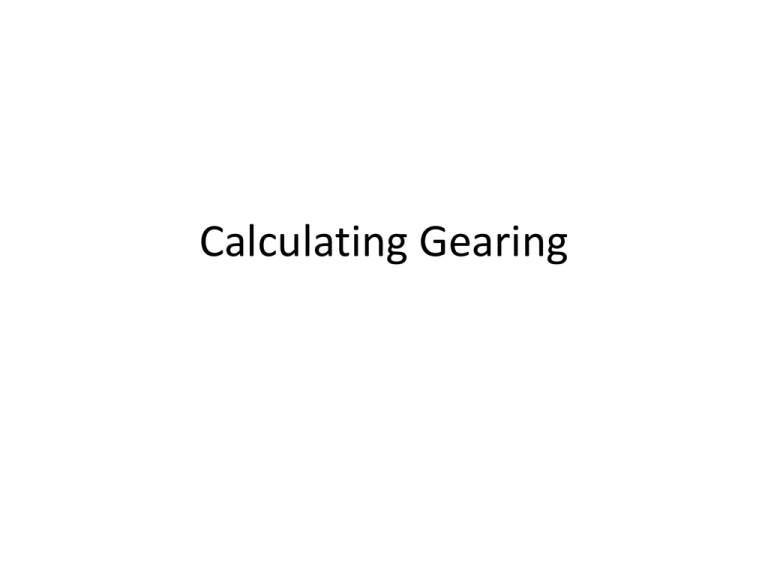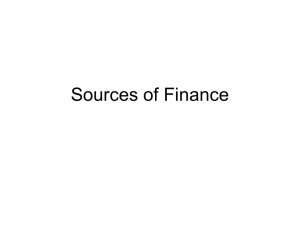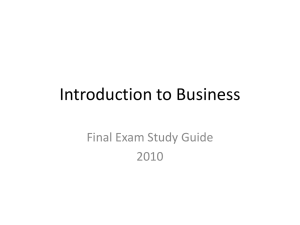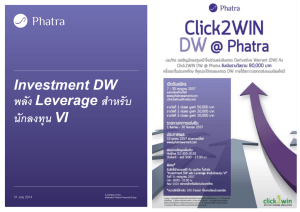Calculating Gearing - Business Studies A Level for WJEC
advertisement

Calculating Gearing What does gearing measure? The gearing ratio looks at the relationship between the debts of a firm and other forms of capital. Money to pay for a firms assets can come from shareholders, profit retained by a business, or money borrowed from lenders When we look at gearing we ask the question; ‘what % of the firms money has come from lenders’? Why measure gearing? As we have already said gearing looks at the relationship between the debts of a firm and other forms of capital. It is useful to know this relationship because; • If gearing is low it tells us that the firm has the ability to borrow money to invest • If gearing is high it tells us that firm might have difficulty in increasing borrowings • If gearing is low then profit will not be used making interest payments • If gearing is high it could mean a large part of profits are used in paying interest payments and less profit is available for investment or for payment of dividends What figures do we need to measure gearing? 2012 (m) 2011 (M) 247 231 Stock 147 141 Debtors 70 59 Cash and Bank 24 86 Total Current Assets 241 286 Current Liabilities 303 261 Net Current Liabilities/Assets (62) 25 Total Assets less Current Liabilities 185 256 Long-term Liabilities 24 29 Shareholders’ Funds 161 227 Capital Employed 185 256 Fixed Assets Current Assets For gearing we use figures from the firms balance sheet. The figures we use are •Long Term Liabilities •Share holders Capital or Funds On the account to the left we can see both Long Term liabilities and Shareholders Funds 2012 (m) 2011 (M) Fixed Assets 247 Gearing = 231 The formula we use to calculate gearing is Current Assets Long Term Liabilities (LTL) Stock 147 141 LTL + Shareholders Funds Debtors 70 59 Cash and Bank 24 86 Total Current Assets 241 286 Current Liabilities 303 261 Net Current Liabilities/Assets (62) 25 Total Assets less Current Liabilities 185 256 Long-term Liabilities 29 Shareholders’ Funds 24 161 227 Capital Employed 185 256 + times 100 1 times 12.9% = gearing % 100 1 = Balance Sheets can be presented in slightly different ways. In this example from a past paper question, LTL are shown above the balancing figure of £1742m, and Shareholders Capital is broken down into Share Capital and Reserves. But we still use the same figures and the same formula. So 1773 1773 + 1742 times 100 1 = 50.4% Of course we could have put in the figures for Share capital (£91m) and Reserves (£1651m) instead of Total Shareholders Capital – but the answer would be the same Discussing your answer So you have calculated gearing, what can you say about your answer? The firm has a gearing level of just above 50%. This tells us that around half of the firms capital has been borrowed. 50% is not too high a figure, after all it makes sense to borrow money to expand, and use profits earned from the expansion to pay back the loan. If we look at the gearing figure for the previous year, the result is 40.1%, so there has been quite a jump in borrowing. This means increased interest payments, but if borrowing has resulted profitable investments, this should not be a problem. Fixed Assets 2012 (m) 2011 (M) 247 231 Current Assets Stock 147 141 Debtors 70 59 Cash and Bank 24 86 Total Current Assets 241 286 Example Question Analyse the change in the firms gearing over the two years. 2011 + Current Liabilities 274 261 Net Current Liabilities/Assets (33) 25 Total Assets less Current Liabilities 214 256 Long-term Liabilities 74 49 140 Reserves 106 34 Capital Employed 214 Shareholders’ Funds Share Capital 67 256 100 1 = 19.1% times 100 1 = 34.5% 2012 + Capital Employed times













